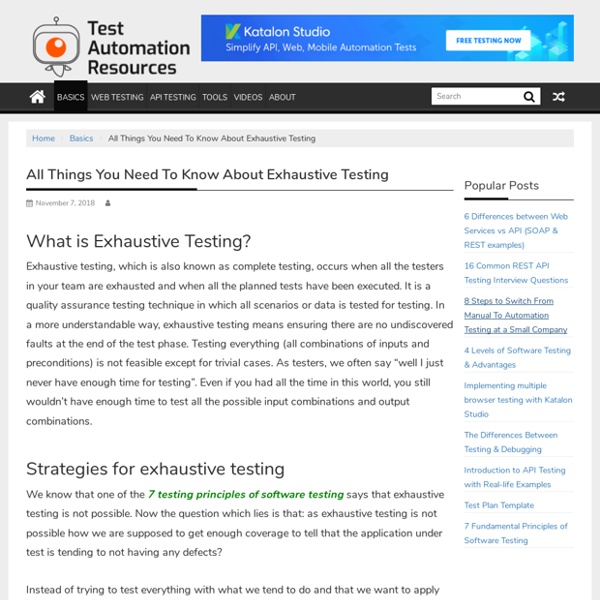Handling Automated Regression Testing In The Most Effective Way
What is regression testing? Regression testing, which is also known as repeated testing, is the process to ensure all the old functionalities still correctly works with the new changes. In other words, handling regression testing is to test an already tested application to find defects as a result of the changes. This is a usual step of any software development process and done by testing specialists.
The Difference between Manual & Automated Testing
In the previous article, we already learned about Software Testing in general (Software Testing Introduction, Software testing type). Software testing is a huge picture with many pieces, but people nowadays tend to categorize it into 2 main types: Manual Testing & Automated Testing. This article will show you “The difference between Manual & Automated Testing” and “Why early apply Automation is worth the effort”.
Getting Started with REST API & RESTful Web Services Testing
REST API & RESTful web services explained REST API, which stands for representational state transfer application programming interface. Some of the simplest questions that might come up when you’re first starting to understand REST API is, what is being represented exactly, what is a state, and what is being transferred. So here in the article, let’s look at all these words individually and learn what they all mean. The word ‘representational’ means there is a transfer of representations of resources and the resources can be pretty much anything that can be named on the Internet like a list of users or a list of photos, comments, posts, articles, pages, videos, books, profiles, etc.
Software Test Automation Engineer Salary and Career Overview in 2019
In this article, I will show you why gaining test automation skills are needed for your quality assurance career if you want to remain marketable as a tester. I will tell you what technical skills and automation tools you need to learn about if you’re just getting started with test automation. Why you should be an automation tester? Automation testing is not a new concept in the software development industry anymore, but it is still one of the fastest growing trends. As you may have heard, doing less can help you achieve more.
Implementing multiple browser testing with Katalon Studio
Introduction This tutorial gives a brief information on how to run a test case in multiple browsers. Katalon makes easier to do grid option in automation testing without downloading any external resources. With Katalon multiple browser testing can be done with simple steps. Requirements How to implement multiple browser testing using Katalon Studio?
What is CI/CD? Continuous Integration & Continuous Delivery
CI/CD is the acronym for the combined practices of Continuous Integration (CI) and Continuous Delivery (CD). CI/CD practices are currently the most widely accepted choice to shorten software development and delivery cycle time. In today’s ever-evolving landscape, one of the top challenges for software companies is quickly responding to market and customer demands. And CI/CD methodology emerged as the pivotal solution to such a challenge.
Introduction to Continuous Testing
Customers nowadays expect top-notch software for their businesses or personal use. To accommodate that need, software companies are incorporating Continuous Testing practices to ensure the software they release to market can outshine the competition. What is Continuous Testing? Continuous Testing is a software testing type in which the product is evaluated early, often, and throughout the entire Continuous Delivery (CD) process. Continuous testing uses automated tests to ensure teams receive immediate feedback to quickly mitigate as many risks as possible throughout the software development lifecycle.
Katalon Studio
Does your business plan include a continuous testing strategy? Is continuous testing right for your organization? Every company who has implemented continuous testing had to answer these questions – and not all companies are able to do so. It requires a strategic planning process and many changes would need to be put in place, which can be challenging for small and large organizations alike. After all, continuous testing is all about testing early and often which can be challenging to implement.
What is End-to-End (E2E) Testing?
End-to-End Testing: What is it? End-to-end testing is a technique that tests the entire software product from beginning to end to ensure the application flow behaves as expected. It defines the product’s system dependencies and ensures all integrated pieces work together as expected.
4 Levels of Software Testing & Advantages
Before release, any software product goes through various levels of testing to make sure that it is working properly. But, generally, software testing is divided into four levels and in this article, we will focus on the 4 main levels of testing: Unit testingIntegration testingSystem testingUser acceptance testing. 1. Unit Testing Unit testing (or component testing) is the first stage in the testing process.
The Essential Guide To API Testing
Overview API testing, or Application Programming Interfaces testing is a kind of software testing that involves verifying and validating APIs and Web services. It’s also a part of integration testing which determines whether the developed APIs meet the tester’s pre-established expectations, such as functionality, reliability, performance, or security. API testing is entirely different from testing.



